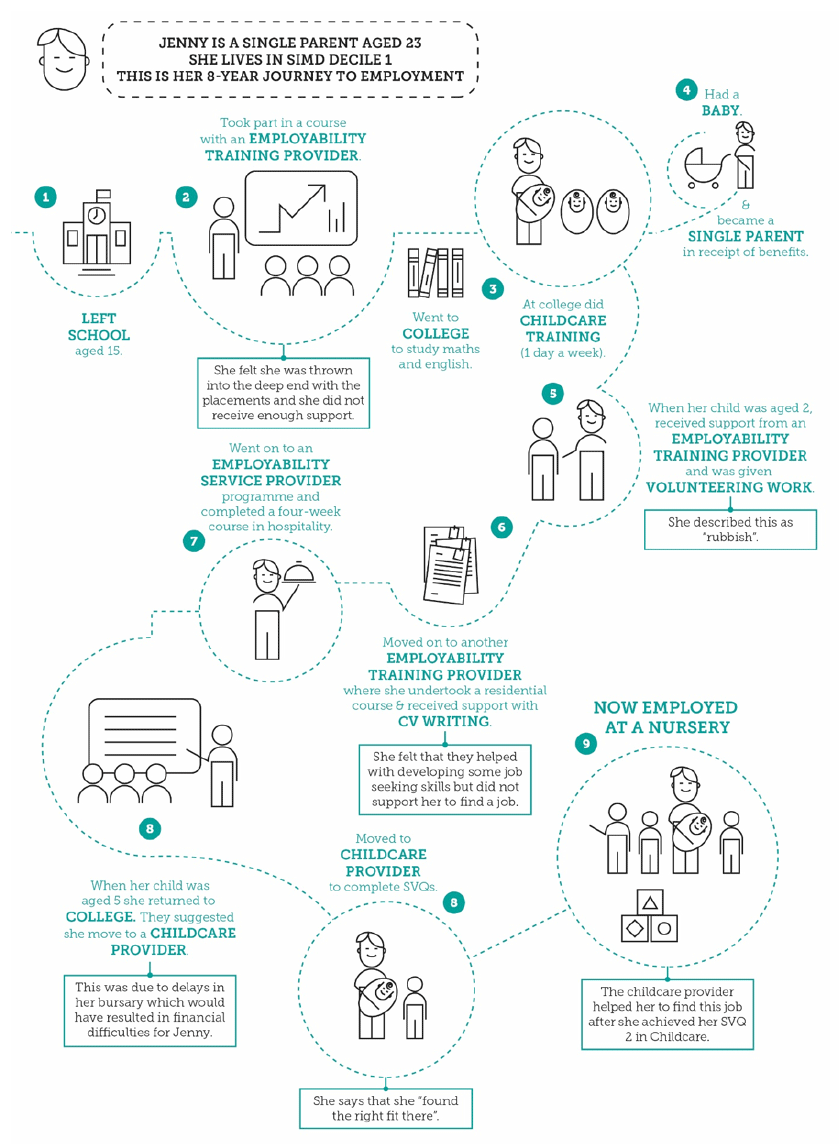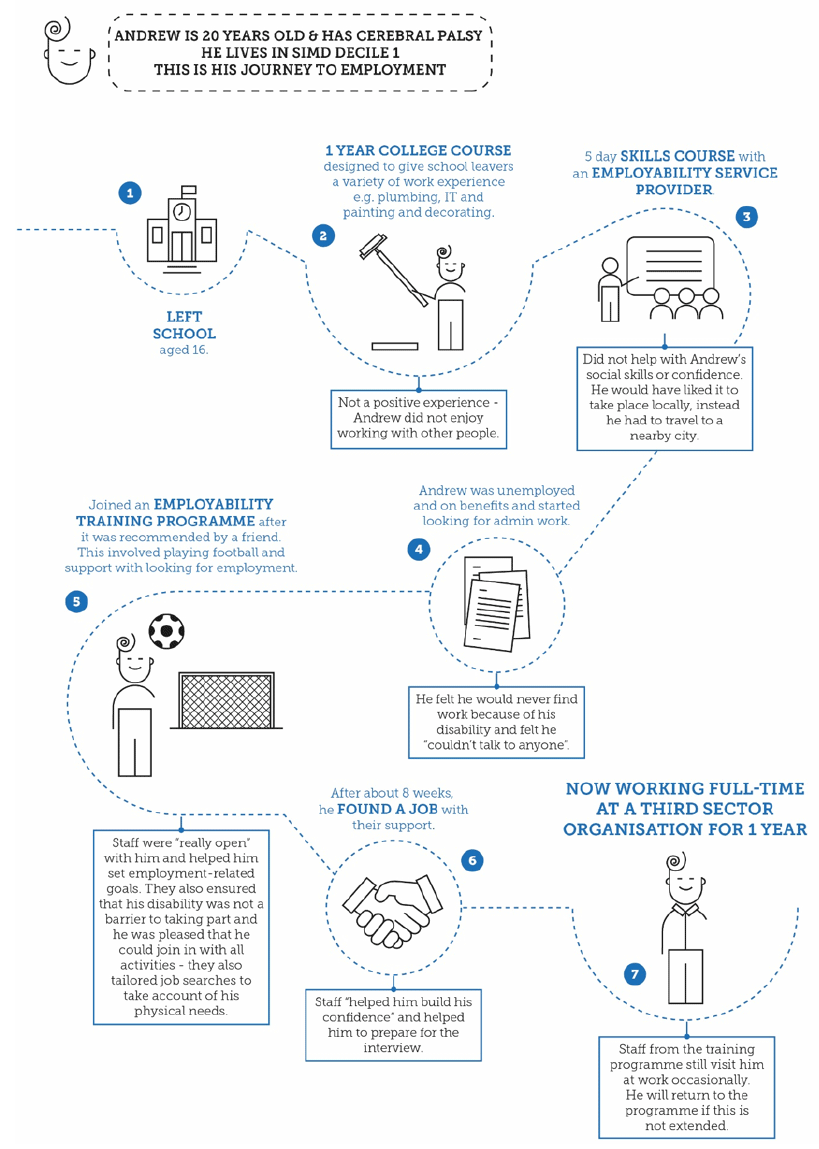No One Left Behind: review of employability services
Steps the Scottish Government will take to develop an employability system which is flexible, joined-up and responsive.
The Evidence for Change
"It is certainly true that, as the depth and complexity of disadvantage increases, responses need to be tailored to individual need…"[1]
– Naomi Eisenstadt CB ‘The Life Chances of Young People in Scotland: Report to the First Minister’
Whilst we have set out the values and principles that will underpin our employability system, we have drawn on existing research and listened carefully to the views of service users, training providers and other partners to understand how the system can work better, especially for those who need additional help and support.
Many of the challenges faced by the people who use services within the current system have been clearly and succinctly set out through the significant body of available research and reports from both the Independent Advisor on Poverty and Inequality and Race Equality Framework Advisor, as well as the Cambridge Policy Consultants report: Review of the Allocation of Employability Resources in Scotland
This work challenged us to look at how we develop a system that is more straightforward for people to navigate; that channels resources into where they are needed most; and that enables us to better measure the effectiveness of what we do.
With this in mind, over the summer 2018, the Scottish Government held nine engagement sessions across Scotland with key partners. These events provided opportunities to discuss current challenges with the system and explore what can collectively be done to improve employability services.
In No One Left Behind we made clear that there are a significant number of organisations involved in the employability landscape: as assessment and referral organisations; as deliverers of skills and training; funding providers, or a combination of these. It was important that we engaged with all these organisations during the review process and we have. In addition to the nine roundtable events, we have spoken to many organisations at other events, and received a number of written submissions.
The roundtable events took place between May and August and were held in Glasgow, Stirling, Inverness, Edinburgh, Lanark and Ayr. They were attended by more than 100 people, including: Local Authority and Third Sector employability providers, representatives from Developing the Young Workforce Regional Groups, and representatives from national organisations, such as COSLA, the Scottish Funding Council and Colleges Scotland, to name only a few.
Sessions were well-attended and participants were candid with their views, positively engaging with the process and welcoming the opportunity to be involved in shaping the future delivery of employability services.
We also commissioned research which engaged both service users and providers seeking their views, to help us develop our understanding of the range of user journeys. Examples of these journeys are set out at Figures 1 and 2. That report, setting out findings from the research, will be published alongside this plan.
We have highlighted below the main issues raised in the sessions, as well as several best practice approaches that were discussed, identifying a range of possible ways to improve the delivery of employability services in Scotland.
Figure 1

Figure 2

- We heard that the flexibility of provision and funding should be able to reflect the varied needs of users and their different rates of progress towards work. Those in more complex circumstances are more likely to experience significant setbacks in their personal lives and the employability system should be able to adapt to provide the support required regardless of whether the user is in work or just beginning to develop their employability skills.
- Many stakeholders suggested that the Scottish Government needed to enable more joined-up approach to funding employability services, for example, by acting as an enabler for the delivery of regionally aligned services. Aligning spend across organisations could improve the delivery of objectives and outcomes, bring about greater consistency of administration practices and ultimately benefit service users.
- The importance of the Trusted Professional or mentor was highlighted as a vital way to gain the confidence and trust of many service users. Having a dependable relationship between a user and mentor can build trust with service providers, helping users to articulate the specific services they need that reflect their capabilities. Mentors were specifically mentioned as a role that helps maintain a continuous relationship and can provide initial soft skill support, on-going assessment of progression, and in-work advice to both the user and also the employer, ensuring a smooth transition through each stage of support.
- The role of Third Sector provision was viewed as vital for the success of the employability system. It was felt that a closer working relationship between national, public sector and third sector bodies was fundamental to ensuring coherent delivery of local services.
- Participants noted that further discussion is needed to develop a shared view of effective delivery geographies.
- A key issue raised during the conversations was the needs of rural employability services. There are fewer services available when compared to cities, as well as a reliance on smaller charities and locally based social enterprises. Many stakeholders noted that how resources are allocated should reflect the increased cost of delivering services and the specific barriers service users in rural areas face, including travel.
- Better integration of the employability system with other services, including mapping the impact on eligibility for different services, with wider support including health and housing services was seen by many as a crucial step forward.
- It was felt that the employability system would benefit from a national approach to measurement and outcomes which would improve data quality and consistency. Whilst the importance of retaining a focus on helping people into sustained work is clear, there was support for measuring and rewarding labour market progress, such as ‘confidence gained’ or ‘engagement with others’.
- Participants indicated that the skills needs of both individuals and employers should be better aligned to inform the employability training available in specific areas. A more joined-up approach could enable users to gain the confidence and transferable skills needed for a variety of jobs helping them move between jobs and progress in their chosen field regardless of age.
- Participants pointed out the variety of approaches to planning and resourcing employability services and provision that takes place across local areas. For example in some areas staff are recruited to deliver services directly while in other areas, provision is purchased from the third sector. It was felt that Local Employability Partnerships were the best mechanism through which to effectively align services and identify local area needs.
- It was noted that there are considerable differences in the approaches to administration of the various employability programmes currently available in terms of eligibility criteria and the evidence required to be submitted in support of outcomes, as well as performance requirements. The variety of approaches intensified the resource requirements and many people suggested that a standard, lighter touch approach would be more beneficial.
- We heard that partners would welcome further dialogue on how to develop a more co-ordinated and effective approach to working with employers.
- A focus of participants concern was the long term funding plans following the anticipated end of European Structural Funding in 2022. There is a call on Scottish Government to work with partners to ensure future employability funding is sustainable and that employability services are resourced to deliver for service users.
- Stakeholders sighted the challenges around the availability, quality and the limited opportunity to share data across the employability system. A system response is required to make the best of the data available and to consider what data is needed to help deliver the employability system we need. This would include information that would support providers to work more collaboratively across sectors to achieve goals and outcomes and create a culture of continuous improvement.
There is a problem
Thanks for your feedback